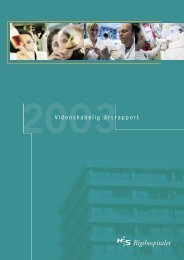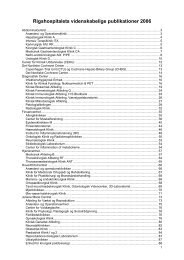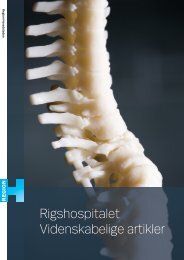View - CTU
View - CTU
View - CTU
You also want an ePaper? Increase the reach of your titles
YUMPU automatically turns print PDFs into web optimized ePapers that Google loves.
1agement for caries<br />
ie for inclusion, but<br />
>f pulp treatment of<br />
irther well-designed<br />
d the gold standard<br />
2001, Gluud 2006a)<br />
31uud 2006a, Gluud<br />
:ing adequate trials,<br />
fom errors ('play of<br />
1iews of such trials<br />
d pulp inflammation<br />
1. The variation may<br />
re the status of the<br />
1 rate of the caries<br />
e outcome of deep<br />
hat a decision must<br />
::1, and this warrants<br />
1ould relate to the<br />
s invasive stepwise<br />
vation versus direct<br />
>osure, 1-year pulp<br />
:ures.<br />
~s partial pulpotomy<br />
Aim /fib:<br />
To carry out a randomized clinical trial comparing direct pulp-capping versus partial<br />
pulpotomy of pulps exposed as a result of caries, using 1-year pulp vitality without<br />
apical radiolucency, and pain, as the outcome measures.<br />
Context:<br />
Danish National Health Insurance<br />
Remuneration system<br />
Fig. 5. In Study Ill an endodontic preventive strategy is investigated.<br />
Trial designs (Study Ill)<br />
Study Ill<br />
An endodontic<br />
preventing strategy -<br />
randomized clinical<br />
trials investigating deep<br />
caries excavation<br />
Definitions of patients to be enrolled in the two randomized clinical trials<br />
The number of patients needed to explore the hypothesis was found on the basis of a<br />
sample size calculation (excavation trial): 134 patients were needed in each group to<br />
detect a 20% difference between stepwise excavation and direct complete<br />
excavation at a two-sided alpha level of 5% (type I error) and 90% power (type II<br />
error of 10% ), when expecting 50% in the direct complete excavation group to retain .<br />
pulp vitality without apical radiolucency after 1 year. The study needed at least 308<br />
patients, taking a possible patient drop-out rate of 15% into account (134 x 2 x 1.15).<br />
Consecutive patients referred to two Danish centres and four Swedish centres<br />
participated. Sample size calculation was performed for the excavation trial only, as<br />
the enrolment of patients to the pulp capping trial would be restricted to the actual<br />
numbers of exposed pulps in the excavation trial. In this light the results of the pulp<br />
trial would be difficult to assess and this trial should be considered a 'pilot trial'.<br />
Inclusion and exclusion criteria were well-defined in both trials (Study Ill).<br />
17








